Web developers are often mixed-up with web designers because they share some similarities, and they complement each other when building websites. The main difference between a web designer and a web developer is the technical know-how. Web designers focus on the visual aspect, the feel and look of a site, while web developers do the background work such as coding and technical implementation to make sure it functions. Web designers, by nature, work with code somewhat, but they are not as well equipped to build your website. That piece of the project should be left to developers.
To understand the concepts of web design and web development, it’s important to outline the roles they play in the creation of functioning websites and apps. This will help you decide whether you need a designer or a web developer for your project or, if you are a job seeker, which career path is best for you.
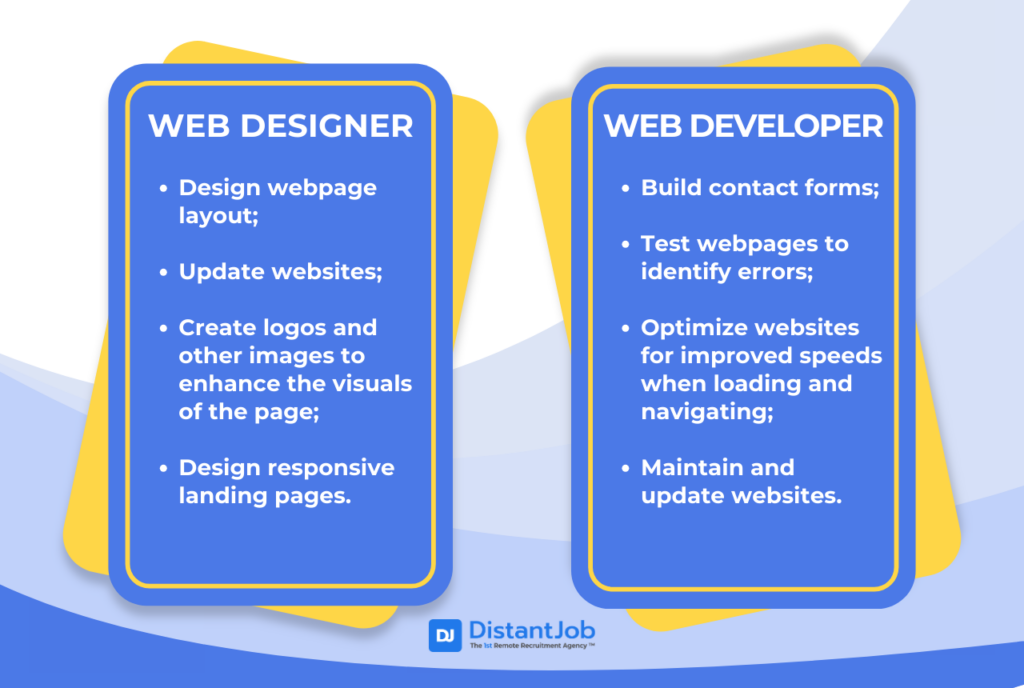
Let’s explore the primary roles and the main differences between web developers vs. web designers.
What´s The Role of a Web Designer?
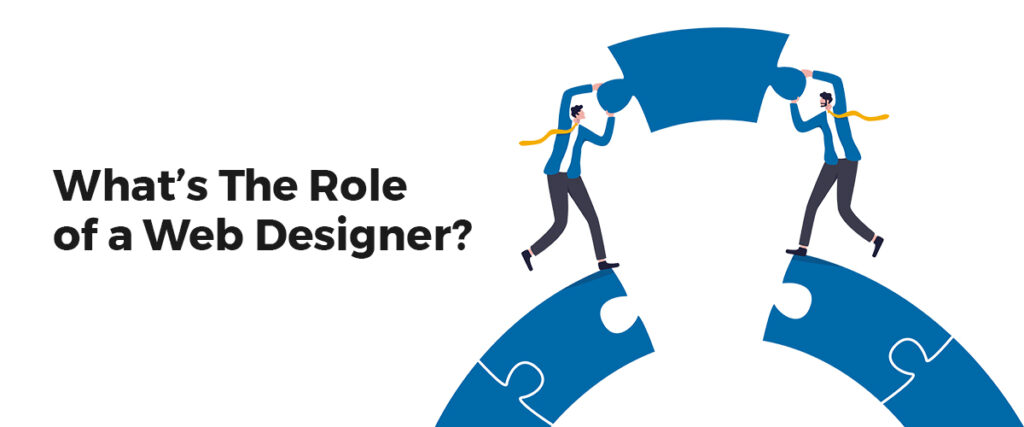
Web designers mainly focus on everything involved with the visual aesthetics and usability of a website.
Web designers are great connoisseurs of color schemes. They can build great website layouts and understand how everything should be set up for users to have a great experience. They relate mostly to the aspects of UI/UX.
Web designers are also highly experienced in using digital creative software such as Photoshop and Illustrator to develop website designs that are in line with the branding strategy. Through this, they can create logos, color schemes, and typography that will help to create a cohesive and recognizable brand.
Having an attractive and usable website is incredibly important because it incentivizes users to stay and use the website for longer. According to statistics, 94% of first impressions are related to your site’s web design.
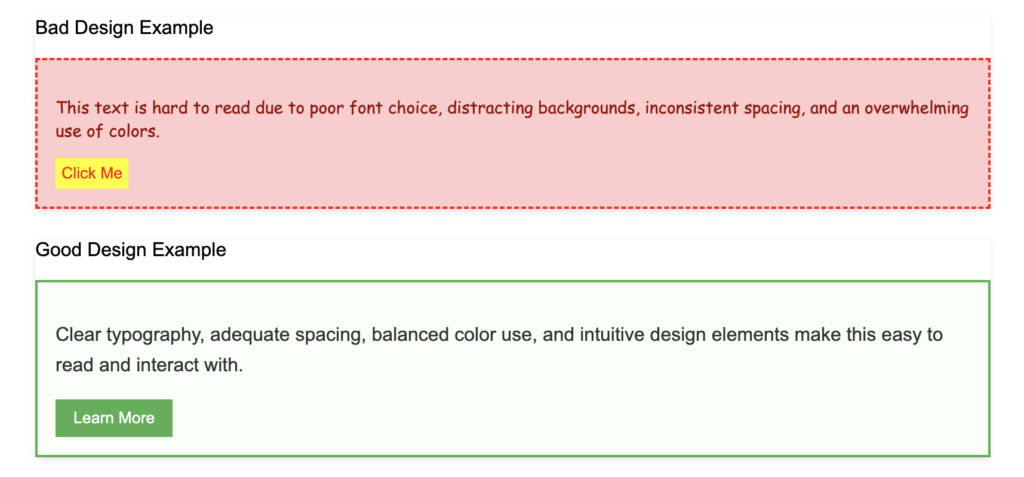
Main Responsibilities
Being related to the User Interface (UI) and User Experience (UX) of websites, Web Designers are mainly involved with:
- Conceptualizing creative ideas
- Establishing design, guidelines, standards, and best practices
- Defining the functionalities and features of the website
- Designing and testing the website
- Identify opportunities to improve the user experience
Types Of Web Designers
Web designers have three main aspects to their work:
- UI Designer
- UX designer
- Visual Designer
| User Interface (UI) Designer | User Experience | Visual Designer |
| These designers focus on the way each page is built. They deal with a page’s structure, deciding what kinds of elements the pages have and what they do when interacted with. | These designers see the website in a more broad sense. They are responsible for creating the flow of pages of the website and research how that resulting page hierarchy changes and entices users to interact with the website itself. | These designers are responsible for creating and/or maintaining the visual elements of a page: images, logos, colors, text fonts, etc. They use these concepts to define the visual language of the website and are tasked with keeping that language consistent with the brand and also throughout the whole webpage. |
In most cases, web designers will encompass most, if not all, of these roles at once. Big companies or highly technical teams will want specialists in each of these aspects so each can focus on different design decisions to guarantee the success of a website project.
Key Skills of a Web Designer
- HTML and CSS
- Prototyping and Wireframing
- Marketing and communication design
- User Experience (UX) design and interactive design
- Responsive design (the ability for a page to dynamically change its layout based on the size of the screen)
- Progressive enhancement (the ability for a page to dynamically load enhancements based on the capabilities of the browser while still presenting the content)
- Page layout
- Typography
- Motion graphics
Web Design Tools
- Wireframing/Mockup Tools: Mostly used to help communicate to the rest of the team (and possibly clients) how the website will look and feel. Also helps with developing a smooth UX.
- Graphics Editors (both Raster and Vector): To create the variety of graphics needed for the website’s look.
- Coding/Debugging Tools: It’s especially important for designers to have tools that allow them to visually develop their mockups and see changes made in real time in order to iterate quickly.
How Much Money Does A Web Designer Cost?
According to recent reports, the average salary of a web designer ranges between $52,315 to $60,015. However, this value will change dramatically depending on the location of your designer. You can hire remote developers with the same quality as local ones but with far more competitive salaries.
What´s The Role of a Web Developer?
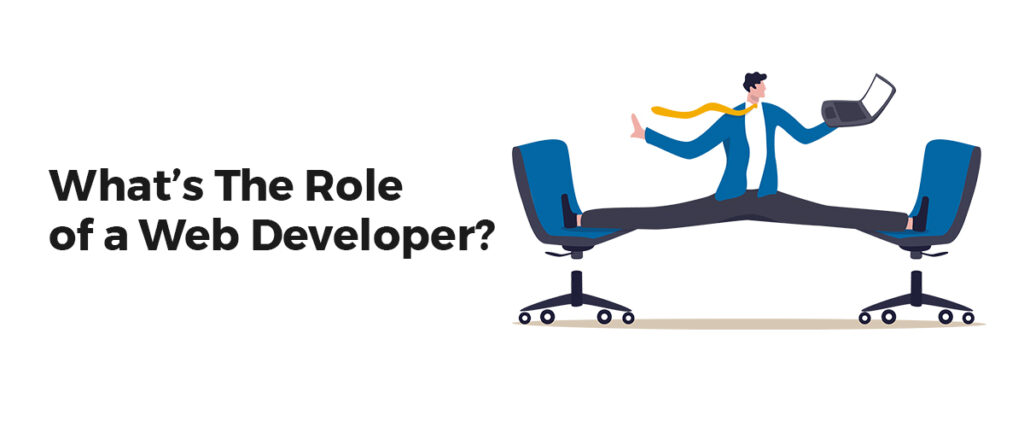
Web developers build and maintain websites. Their primary purpose is to create functional websites that give users the best experience. They take a website design and project and make it into reality. This is why they are involved in the more technical aspects of development. They need to learn programming languages, most commonly PHP, Java, and Ruby (among others).
💡 Interested in learning about the difference between a web and a software developer?
Main Responsibilities
- Create a website using JavaScript, PHP, and other web-centric languages, with the help of some basic HTML and CSS
- Testing and debugging a website’s code
- Write efficient code
- Maintain software documentation
- Work closely with project managers and designers to realize the project’s vision and goals
Types Of Web Developers
There are three types of web developers:
- Front-end developers
- Back-end developers
- Full-stack
| Front-end developer | Back-end developer | Full-stack developer |
| They are highly skilled in UI (user interface) and UX (user experience). They oversee the visual aspect of websites; therefore, they often work side by side with web designers. Front-end developers focus on the functional elements. | They ensure that the website runs efficiently by maintaining the server-side code. This way, data runs efficiently throughout the website, from the front end (what the user interacts with) to the back end (the database). | They take care of both parts of a website, front and back. |
Examples of poor and good web development skills

Do You Need A Web Designer and a Front-End Developer? What’s the Difference
The difference between a web designer and a front-end developer lies in their focus and skill sets. While web designers focus on how a website looks and feels, front-end developers focus on how those designs are brought to life and function on the website.
A web designer concentrates on a website’s visual aesthetics and user experience (UX). Their main responsibility is to create the visual layout, style, and overall feel of a website, ensuring it is visually appealing and user-friendly. They provide design mockups and prototypes that define how the website will look.
On the other hand, a front-end developer focuses on implementing the web designer’s vision using code. They are proficient in HTML, CSS, JavaScript, and front-end frameworks like React, Angular, or Vue.js. Their responsibilities include translating design mockups into functional code, ensuring the website is interactive, responsive, and performs well across different devices and browsers. Essentially, front-end developers build the actual website based on the designs provided, making sure the user interface works smoothly.
Skills Required for Web Developers
- HTML/CSS (Front-end)
- Responsive design (Front-end)
- JavaScript (Front-end and Back-end)
- PHP (Front-end and Back-end)
- Testing and debugging (Front-end and Back-end)
- Code versioning (Front-end and Back-end)
- SEO (Front-end and Back-end)
Even though Front-end and Back-End developers have different skills, they both should know the basics of the other to have better communication and interface with each other’s work.
Web Development Tools
- Frameworks and Libraries: Every web developer should be familiar with the most popular frameworks and libraries for either Front-End or Back-End solutions. This will allow them to be flexible and easily adapt to the reality of any given project.
- Integrated Development Environment (IDE): Choosing a development environment that helps with the most common and mundane tasks, streamlines the coding process, and helps with debugging.
- Deployment/Monitoring: The work doesn’t stop when a website is published. Developers should keep maintaining it to make sure they run at peak efficiency and that other secondary functions (such as SEO) are working as intended.
What’s Their Salary Distinction?
According to recent reports, the average salary of a web developer ranges between $60.262 to $89.985. If you want more competitive salaries, the best option is to hire remotely. You can get developers with the same quality as the local offering but not offset your budget.
Developer vs Web Designer: 5 Key Differences
As we’ve established, web developers and designers share many similarities, but also have key differences. The main difference is that a developer writes and maintains code, while a web designer does the visual and aesthetic side of the website coded by the developer.
Here are the top 5 you should be aware of:
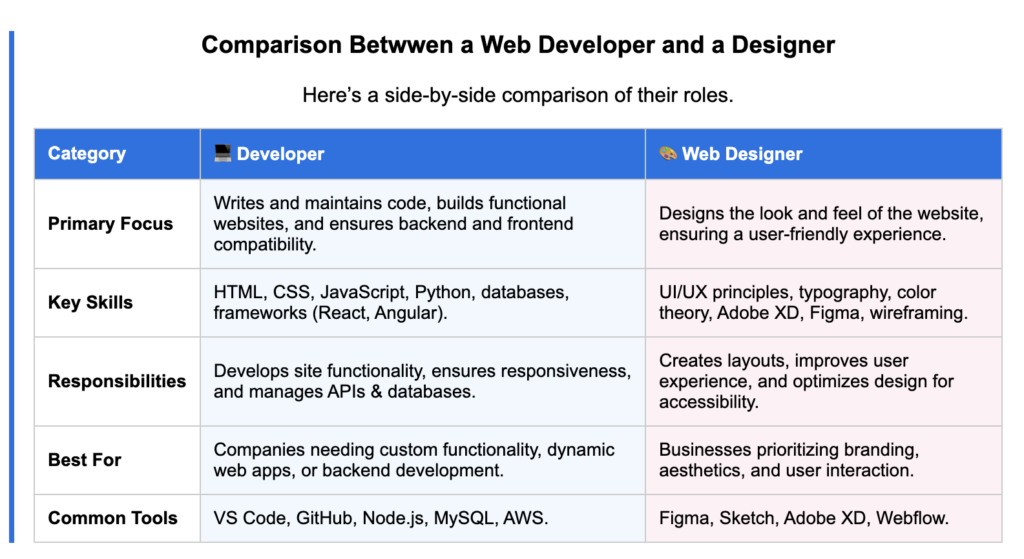
Designer, Developer, or Both? Here’s How to Decide
Your project’s goals, scope, and technical needs determine whether you should choose a web designer or a web developer. Both play key roles in creating a successful website, but their skills differ. Here’s how to decide which one suits your business.
When to Hire a Web Designer
If your focus is on your website’s appearance and feel, you should hire a web designer. They create appealing, user-friendly experiences that match your brand.
You’ll want a web designer on your team when:
- Brand Identity and Visual Design: When you’re building from the ground up or changing your brand image, a web designer ensures that your website showcases your brand’s colors, fonts, and overall look.
- User Experience (UX) and User Interface (UI) Design: To make your site easy to use and straightforward, a web designer arranges pages, buttons, and menus for the best user journey.
- Website Redesigns: If you have a website but want it to look more up-to-date, polished, or in step with current design styles, a web designer can give it a facelift.
- Landing Pages and Marketing Campaigns: When you need landing pages or campaign pages that convert well, grab user attention, and guide them to take action, web designers are your best bet.
If you want your website to look good, be easy to use, and match your brand, you need a web designer. They’re the experts who can make this happen.
When to Hire a Web Developer
If you’re more worried about how your website works and performs, you need a web developer. Their job is to take what the web designer creates and turn it into a website that works well and lets users interact with it. They handle all the behind-the-scenes stuff to ensure your site runs smoothly and efficiently.
Here’s when you should get a web developer:
- Custom Features and Functionality: A web developer can bring to life features like contact forms interactive elements, payment gateways, or custom dashboards if your site needs them.
- Responsive and Mobile-Ready Sites: A web developer will make sure your site works well on all devices, from desktops to smartphones, if it needs to be responsive.
- E-commerce Websites: Web developers handle shopping carts, payment processing, and secure checkouts.
- Page Speed and Website Performance: A web developer will improve your website’s speed and performance if it loads or lags.
If your website needs to handle tasks like processing payments, gathering customer info, or providing unique features, you’ll need a web developer.
When You Need Both
Often, you’ll want both a web designer and a web developer to complete your project. While one cares about how things look and feel, the other ensures everything works under the hood. Here are some situations where you’ll benefit from having both roles:
- Building a Full Website from Scratch: When you create a website from scratch, you’ll need both design and development. The designer will handle the layout, look, and feel, while the developer will bring it to life.
- Redesigning a Functional Website: When you want to give a new look to an existing website that’s already live, you’ll need both roles. The designer will focus on visuals and UX, while the developer will make sure the new design keeps the site’s existing functionality intact.
- E-commerce Websites: E-commerce sites have visual complexity (product galleries, promotions, etc.) and technical complexity (payment processing, inventory management), so designers and developers need to work together.
- Custom Web Applications: When your website needs particular functions—like SaaS products or company tools—you’ll want designers and developers to work together side by side.
If you’re unsure which one to hire, ask yourself: Do I want to change my site’s appearance or functionality? If it’s about the look, you need a designer. If it’s about how it works, you need a developer. If it’s both, get both—or even better, find a team to offer both services.
Conclusion
Now you know the differences between web design vs. web development!
While web designers and developers may seem similar at first, they have very different responsibilities and use different skill sets.
Web Designers are responsible for the look of a webpage, including the Page Layout, Interaction, Animations, and User Experience.
Web Developers, on the other hand, are responsible for the functionality of a webpage.
- Front-End Web Developers are responsible for how the page itself functions. They will work closely with Designers to make sure the various elements of a page work and can be interacted with as intended.
- Back-End Web Developers are also indirectly responsible for how a page functions but are more focused on the service the page provides and less on how the page is presented to the user.
In a very simple example, let’s consider a shopping website:
- The Web Designer will work on how the page looks and presents the items to the buyer.
- The Front-End Web Developer will program certain elements of the page itself, such as a buy button or listing the items in a cart.
The Back-End Web Developer will program the behind-the-scenes service that checks the shop’s database for inventory and prices and validates all purchases.
If you’re looking to hire a web designer, a web developer, or both, DistantJob can connect you with top-notch remote professionals. We focus on finding skilled experts from across the globe to fit your specific project requirements. Whether you need front-end developers or UI/UX designers, we’ll link you up with pros who get your vision and can make it real. Get in touch today, and we’ll build something amazing together.
FAQ
According to the U.S. Bureau of Labor Statistics, web designers’ overall employment is projected to grow by 23% between 2021 to 2031. This will translate to an average of 21,800 job openings each year.
Web developers are skilled in coding languages such as HTML, CSS, JavaScript, and back-end technologies like PHP or Python, focusing on building and maintaining the website’s functionality while web designers specialize in graphic and user experience design, using tools like Adobe Photoshop and Figma to create visually appealing layouts and interfaces.
In short, web developers are responsible for writing code, while web designers create the design.





